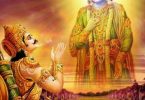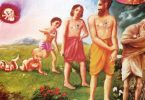Question: I have read that all living entities are generated from tatastha- shakti (Srimad Bhagavatam 3.7.9). Living entities can be influenced by the internal or external potency of the Supreme Personality of Godhead. Please explain how the living entities behave while under the influence of Tatastha-sakti. Is the marginal potency an intermediate state between Pradhan and Prakriti? How long they belong to this region of marginal energy of Lord? What is the characteristic of marginal potency with regards to internal and external potencies?
Answer by Romapada Swami: There seems to be some fundamental misconception in how you relate the living entities to the tatastha-shakti within your question. Lord Vishnu or Krishna is the Supreme Energetic and He possesses multifarious energies. These energies are generally classified into three principal categories, one of which *is* the living entity belonging to the tatastha category (marginal energy).
The statement from Vishnu Purana, from which Srila Prabhupada makes this inference in Srimad Bhagavatam 3.7.9, identifies these three distinct categories of energy: “The internal potency of the Supreme Lord, Vishnu, is spiritual, as verified by the sastras. There is another spiritual potency, known as kshetra-jna, or the living entity. The third potency, which is known as nescience, makes the living entity godless and fills him with fruitive activity.” The same idea is conveyed in Bhagavad Gita (Bhagavad Gita 7.4, 5). In other words, the jiva souls are the third category of energy, called marginal energy and they constitutionally belong to that category eternally, sometimes coming under the influence of inferior material potency and otherwise under the influence of spiritual potency; they are not ‘under the influence’ of tatastha shakti as if the latter was another and a separate category.
The word ‘tatastha‘ can be thought of as the meeting place between water and land, as at a riverbank or shoreline. Just as the seashore is sometimes under water and sometimes exposed, similarly the marginal living entities, although spiritual in quality, can either be under the influence of the internal or external energy, which is decided by their own attitude towards the Supreme Lord.
The Bhagavatam purport you have referred to gives a graphic example — although the sun’s rays are qualitatively non-different from the sun, they are sometimes overpowered by another energy of the sun, namely by clouds or by snowfall, although the clouds can never cover the sun itself. Likewise, a spark of fire can become extinguished when it is separated from the original fire. Similarly, although the living entities are qualitatively one with the superior energy of the Lord, because they are marginal they have the tendency to be overpowered by the inferior energy when they turn their attention away from the Lord. The modes of material nature then react upon and cover the ray-like living entities.
Tatastha-shakti therefore refers to the spirit souls and is not an intermediate state between pradhan and material nature. Pradhana refers to nothing but the unmanifested totality of material energy prior to creation and in its manifest state, it is called prakriti – both belong to the category of material energy. At the time of creation, the undifferentiated Pradhana becomes agitated by the glance of Maha Vishnu and at this time the living entities are also impregnated into the material energy. The three modes of material nature and subsequently the 24 material elements then become manifest.







